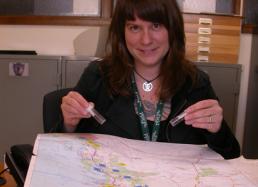1: Back to the AWT
G’day mates! We're leaving tomorrow on a 32-hour plane ride (including layovers) from Chicago to Queensland, Australia. Although most people think of Australia as an arid desert, actually there are large stretches of rainforests along the eastern edge of the continent. My expedition will take me into the heart of one of these rainforests—an area called the Australian Wet Tropics (AWT).
The AWT are remnants left over from millions of years ago, when Australia was actually covered in lush rainforests. As these rainforests began to shrink and become the small pockets found today, the animals, plants, fungi, and bacteria associated with these ecosystems were also forced to retreat into the remaining habitat. It’s here, in these remnant rainforests, where I’ll spend most of my time.
The rainforests of the world are the center for ant diversity, and the Australian Wet Tropics are no exception, with over 1,200 ant species and subspecies. This will be my second trip to the AWT to collect ants, and I’ll be in the field for about five weeks. Preparing for a five-week trip not only means planning your field sites carefully, but also contacting local collaborators, getting all your camping and cooking supplies together, and preparing all your collecting equipment, such as filling thousands of vials with preservative.
Ant collecting can be done with a large team or alone, and I've participated in both in the past. But on this trip, I’ll be traveling with only one other person—my husband, Jay (see Photo #1 below). Although not an ant biologist, Jay is a skilled ant collector. We'll mostly be sampling rainforest habitats, although we'll likely also stop at several dryer outback sites during our five-week expedition.
Although I was able to collect specimens of many species during my last trip in 2007 (typically I collect around 5-30 ants from each nest I encounter), I'm hoping to visit several new field sites and find many new species on this trip. To plan my route through the AWT, I've marked the map with all of the sites where I collected ant specimens in the past (see the blue tabs in Photo #2 below) and all of the sites where I would like to collect specimens during this expedition (yellow tabs). This map will help ensure that I cover the most ground and obtain ants from areas where I'm missing data for key species.
The goal of the project is to help document the species and genetic diversity of ants in the AWT, with the larger goals of understanding how past, present, and future climatic events have impacted or will impact all the species found in these areas. To explain, by using DNA from the ants I collect, I hope to test hypotheses about past geologic and climatic events that have shaped the AWT. This may also allow us to predict how climate changes will affect not just the ants, but also all the other rainforest species in the future.
In addition, I’ll bring back many ant specimens that will be preserved in the growing ant collections of The Field Museum. To learn more about the important role of our ant collections in documenting diversity and monitoring the health of our planet’s ecosystems, please free to browse through the various topics in my "About the Expedition" section. You’ll also discover some fun facts about ants and find out why they’re so much more than just picnic pests.
I hope you’ll enjoy our trip through the ancient rainforests of Queensland, Australia. Although I’ll be focusing on ants, there will be many other unique organisms to see, and I’ll try to share some of these with you along the way. And when I return to The Field Museum, I’ll show you just how we process the ants and conduct DNA research in the DNA Discovery Center.
Thanks for joining me on my trip "Down Under!"
More soon,
Dr. Corrie Moreau




